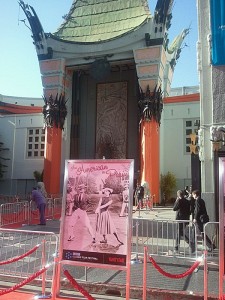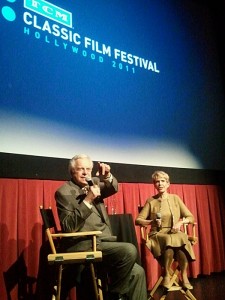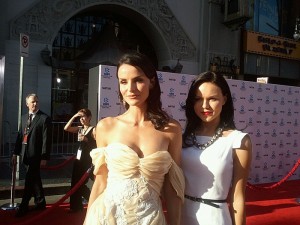Four days of devouring big-screen classics has left me deliciously sated! At least until my next film fest.
About 25,000 people attended this year’s sold-out TCM Classic Film Festival in Hollywood, which featured more than 70 films and special events. Stars who made appearances included Julie Andrews, Alec Baldwin, Drew Barrymore, Warren Beatty, Leslie Caron, Kirk Douglas, Angela Lansbury, Hayley Mills, Peter O’Toole, Jane Powell, Debbie Reynolds and Mickey Rooney.
Before the screening of 1940’s “Fantasia,” in Grauman’s Chinese Theatre on Sunday night, TCM’s Bob Osborne announced that there will be a third fest in 2012. He also announced a new event: the TCM Classic Cruise, Dec. 8-12, 2011, a five-day/four-night event aboard Celebrity Millennium. The cruise will sail from Miami to Key West and Cozumel.
Most important for me was getting my noir fix and, happily, dark delights abounded. For example, there was the chance to see Nicholas Ray’s “Bigger Than Life” with James Mason as a teacher struggling with an addiction to prescription cortisone. As co-star Barbara Rush told Osborne before the screening, this 1956 psychological drama has been programmed in several film noir festivals “because it’s so dark and so scary.”
As you’d expect from Ray, it’s very well done and the performances are excellent. Despite telling the audience that she was “very old,” Rush is very lively. When Osborne asked her to talk about her leading men, she replied, “I had them all!”
Another noir high point was meeting the charming Marya of Cinema_Fanatic and chatting with renowned author Foster Hirsch at the screening of 1953’s “Niagara,” directed by Henry Hathaway and starring Marilyn Monroe (as a murderous wife), Joseph Cotten (as her off-kilter husband) and Jean Peters (as a plucky, pretty brunette). Hirsch told the audience that film noir can absolutely be in color, describing “Niagara” both as a “minor masterpiece” and a “pulp-fiction paperback come to life.”
He pointed out the contrast in lighting between the bright exteriors and dark interiors, ending with the comment: “If you’ve come for laughs and joyous uplift, you’ve come to the wrong place.”
Also a treat was seeing “The Man with the Golden Arm” from 1955. Adapted from a Nelson Algren novel, it’s a story about drug addiction in a gritty urban setting, by master noir director Otto Preminger. I’d seen it before but, as with “Niagara,” the big screen really intensifies the storytelling. It is definitely Frank Sinatra’s best performance and one of Kim Novak’s finest as well. In attendance were Preminger’s daughter Vicki Preminger and Sinatra’s daughters Nancy Sinatra and Tina Sinatra. Rounding out the noir programming were “The Third Man” (Carol Reed, 1950), “Gaslight” (George Cukor, 1944) and “Taxi Driver” (Martin Scorsese, 1976).
Other films with noir elements included Orson Welles’ masterpiece “Citizen Kane” (1941), “The Tingler” (1959), “The Mummy” (1932), “Went the Day Well (1942) and “Whistle Down the Wind (1961). (I saw all but “Kane,” which I’ve seen several times before.)
The festival also honored master composer Bernard Herrmann, who scored “Citizen Kane” and “Taxi Driver” as well as “Psycho,” “Vertigo,” “Cape Fear” and many others.
On the neo-noir front, I’ll be excited to see Cinemax’s upcoming “Femme Fatales” anthology series “about powerful, sexy and dangerous women” starring Ana Alexander and Anya Monzikova, both of whom walked the fest’s red carpet to promote show.
The first of 13 stand-alone episode starts May 13 and I hope to catch up with the actresses sometime soon.














From FNB readers